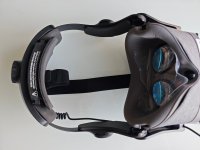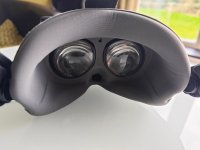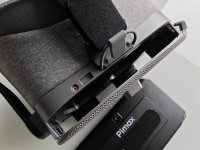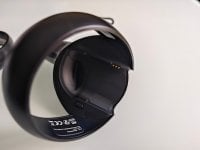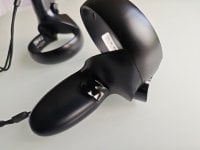Pimax Portal View & VR Mode Impressions
VR hardware manufacturer Pimax generated much hype with their ambitious Pimax Portal hybrid device. It is not only an Android gaming handheld with Switch-like detachable controllers but it also packs a standalone VR mode . In my impressions of the Portal published earlier this year, the handheld’s hardware was impressive and polished even as an “early adopter” version. However, the VR mode was not available, let alone the dedicated View headset to slot the screen in. The View underwent some iterations and the VR mode was still being optimised, hence the delay, but they might soon be publicly available.
In fact, I’ve had the exclusive chance to test both the VR mode and View headset myself and will share my impressions in this article. The VR headset and controller hardware for the Portal should be reflective of the consumer model, but the contents might vary. For instance, I did not receive a packaging box for the accessories; so bear in mind that some of the elements might differ in the final model, hence this being an early impressions piece.
When I first laid my eyes on the View accessory, it reminded me of the Google Daydream headset. If you’ve used the latter, then the Portal View will feel familiar. They both share similar colour templates, a soft fabric finish and a top latch to hold the screen (tablet in the case of the Portal). However, the Portal’s headset bears some notable differences such as the adjustable head strap and a battery pack at the rear that helps in weight distribution.
The overall impression of the View is that of a comfortable headset that bears a quality finish. Having soft, fabric-like material adds to the comfort, especially for the contact points with the face. One major gripe I have is with the back head strap adjustable. I have to place it towards the top of my head to prevent the headset from sliding down to my nose. Getting it right is quite awkward and indicates some room for improvement. Of note, if you are bespectacled and are wearing larger frames, the View headset might be a tight fit but it luckily still accommodates glasses, even if I wish the space was wider. There are also no dioptre adjustments which is worth keeping in mind as well.
In addition, the Portal View and the Pimax Crystal share a similar (if not the same) adjustable head strap and battery pack. This segment of the hardware might very well have been repurposed to use on both headsets. While it’s not a wrong approach per se, I wish Pimax put some more effort in blending the overall design and colour scheme on the Portal’s headset for a more streamlined look. An all-grey or all-black design would work well but for now it’s a mixture of the two.
Furthermore, the battery pack bears the same issues as with the Crystal. This means a finicky removal and charging process, when it would have been easier to charge from the headset itself. However, I do applaud the fact that the battery is removable as this can expand the device’s lifespan. In addition, the extra battery pack means that the VR mode isn’t solely reliant on the tablet’s 3960mAh built-in battery.
The other hardware component is the pair of VR controller mounts. These also look very much like the Crystal’s controllers, which in turn look like the Quest’s controllers. The Portal’s controllers include dedicated grooves to slide in the detachable tablet controllers. These are held tightly in place once slotted in.
Once this has been done, the VR controllers might look odd with the sticking ends of the detachable controllers. But then again the Pimax Portal is not your regular device. The controllers are actually quite comfortable, with the buttons easily within reach. The right controller requires some getting used to as the analogue stick is positioned higher. Thankfully, it is not as uncomfortable as I initially thought it would be. Overall, the controllers are well designed and having the detachable handheld controllers that fit in neatly almost feels like a magic trick, attesting to the well-designed aspect of the package.
To use the Pimax Portal in VR mode, you have to enter the “VR” app on the device, detach the controllers, slide the screen into the View headset and attach the controls to their respective mounts. As the VR mode is still in development, some bugs are to be expected. The most notable one is that it takes some time for the device to initiate the VR mode.
But once it is initiated, it works well. Pimax also told me that there might be some issues depending on the room’s lighting conditions and they are working on addressing these; but I haven’t encountered them during my experience.
The interface is the same as the Pimax Crystal’s standalone mode, and they even share the same standalone VR library. The lobby can be customised with different settings but being able to add/remove items to your liking would make for a more welcome feature and personalised space.
Controls are responsive, whether it’s to navigate or game. I’ve tried Pierhead Arcade 2 and X-Fitness, and the experience was smooth. The Portal’s 4K QLED display really adds to the experience as it delivers crisp and fluid images.
As the Pimax Portal is competing against the likes of the Meta Quest 3 and Pico 4, it should be backed by a decent library of standalone VR games. At the time of writing, this cannot be said for the headset. It’s severely lacking in terms of available games, especially well-known titles. But as this is Pimax’s first standalone VR device, they might grow their standalone library over time.
What makes up for this lack of software is the ability to play Android games in VR mode. I was positively surprised to see that apps that I installed in handheld mode showed up in the library while in VR. I was even more surprised to see that I could even play most of the games such as Dead Cells and Street Fighter IV CE as the Android OS recognises the VR mode as a second display. Unfortunately, emulators like PPSSPP and Dolphin Emulator would not go past the selection screen for some reason.
Nevertheless, being not limited to just VR titles while in VR mode is a great unexpected feature as you can game on a larger virtual screen in a VR environment. One hiccup though is that controls have to be performed with the VR controller acting as a pointer for the touchscreen. You could still pair a Bluetooth gamepad but I think Pimax should explore this feature further, enable the VR controllers to work as controls for Android games in VR and increase app compatibility.
Even if the Portal’s VR mode is being ironed out, my experience has been surprisingly smooth for a pre-release mode. It’s encouraging to see Pimax working to deliver the device’s full potential - even if not as fast as owners of the Portal might wish - and I hope that the VR mode is publicly released soon for Portal owners to enjoy.
If you are looking to get a Pimax Portal, the company is hosting an anniversary discount until December 25th. The non-VR Portal Retro model started at $149 but is now out of stock. The Portal with detachable controllers starts at $300 (128GB) while the QLED model goes for $550 (256GB). GBAtemp readers get a further $20 discount by using the assigned coupon code ‘gbatemp' on the official Pimax Portal page.
